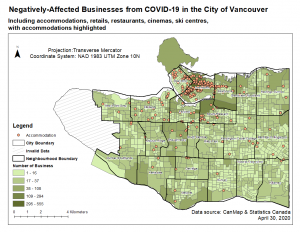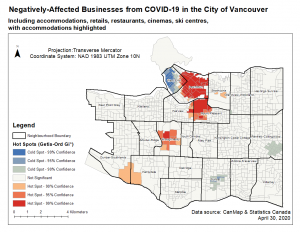During the COVID-19 lockdown period, many businesses are negatively affected. According to Statistics Canada, biggest declines were in wholesale and retail in BC, followed by accommodation, restaurant and food services industry Other industries, such as culture and entertainment, have also seen significant declines (Crawford, 2020). Based on this, five business sectors most likely to be closed during the lockdown were identified, including restaurants, accommodation, retail, and two entertainment businesses, namely cinemas and ski centres. These high-risk business sectors correspond to the high-risk occupations discussed in the previous section.
The first map shows the total number of identified commercial industries within each DA. By simply adding the at-risk industries together, we can observe from the map that both the DAs near the Downtown area and the DAs located in the northeast Downtown have a relatively large number of businesses, indicating that these areas are more affected by the lockdown of COVID-19. I also added a layer that shows where all the accommodations are in Vancouver because this is the sector that indicates the highest intensity in a certain area. We can see that most of the accommodations, such as hotels, are gathered in Downtown.
Based on the map above, a heatmap was created showing the hot spot analysis results of the at-risk businesses in Vancouver during the lockdown. The first hit spot is located Downtown and west of Mount Pleasant. It covers a relatively large area with 99% confidence, which means that a large number of the commercial industries that we identified are concentrated in this area, and therefore it is more vulnerable to the lockdown because they involve public-facing activities and therefore are more likely to be closed.
The second hot spot is found in central Vancouver, especially the Shaughnessy community. This area also shows a cluster of businesses that are negatively affected by the COVID-19, but not as strong as the first hotspots.
There is only one pronounced cold spot being pointed out, which is located in the western downtown, and this community may therefore be considered resistant to disease outbreaks. It is actually interesting to find out that the spatial clustering of at-risk businesses has such a significant difference.

